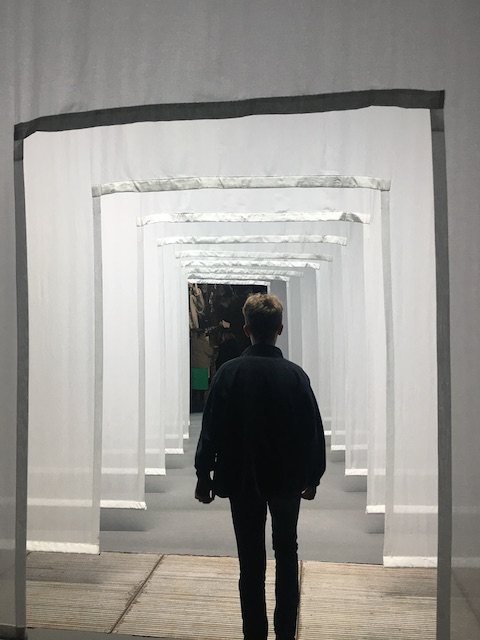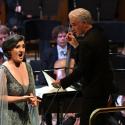This mixed reality concert is simultaneously a dimension juggling conundrum, a philosophical puzzle, and a fascinating insight into what the future might hold. Composer Ryuichi Sakamoto – whose influences included Bach, John Cage and David Bowie – died in March last year, but still lives on in this curiously moving virtual event in which his performance was captured by 48 cameras at 60 frames a second.
The audience is warned at the outset that Kagami – which means mirror – was not motivated by technology but was created by Todd Eckert and his company Tin Drum so that we can connect with Sakamoto. This self-deprecatory warning sets the tone for an engagingly human event in which – while the resonant sound of the Yamaha piano on which it was recorded often transcends the visual effects – we get a beguiling sense of Sakamoto’s musical curiosity.
 We enter the auditorium through a tunnel made of white gauze (see bottom photo); when we reach the other side – literally, and perhaps for some, metaphysically – we are surrounded by large black and white photos of Sakamoto at different points in his life. Then the audience is invited into the main performance area, where everyone is fitted out with “optically transparent devices” (pictured right) through which, at the start of the evening, all you can see is a red cube.
We enter the auditorium through a tunnel made of white gauze (see bottom photo); when we reach the other side – literally, and perhaps for some, metaphysically – we are surrounded by large black and white photos of Sakamoto at different points in his life. Then the audience is invited into the main performance area, where everyone is fitted out with “optically transparent devices” (pictured right) through which, at the start of the evening, all you can see is a red cube.
Sakamoto’s electronic band Yellow Magic Orchestra influenced experimental musicians around the world; throughout the course of his remarkably versatile career he collaborated with David Byrne, David Bowie (famously, in Merry Christmas Mr Lawrence) and film director Bernard Bertolucci among others. Here the red cube disappears to reveal him, in the last months of his life, sitting at a Yamaha grand piano as he begins a solo recital with his song Before Long, the first number on his 1987 album Neo Geo.
One of the fascinating details about this event was that when Sakamoto and Tin Drum were exploring the possibilities, he played a keyboard with weighted keys which worked perfectly in terms of camera angles. It was at Sakamoto’s insistence that the final version was done with a grand piano, something which – according to Eckert – proved a nightmare in terms of camera angles. When the captured data was eventually returned, a few months later, the images were highly distorted at a point when there was no possibility of re-recording with Sakamoto himself. A team of technologists had to painstakingly put the material back together.
What they’ve created is, as the producers acknowledge up front, not perfect – there’s a low-res aspect to what we see which means that it’s difficult to lose consciousness of the artificiality of the experience. This shows not least with the piano itself – details such as the wheels and pedals look yellow rather than metallic. The fact that Sakamoto dematerialises in between each number – presumably to avoid “jumps” in his physical position from one piece to another – also interrupts the capacity to completely lose yourself in the illusion.

The programme reflects the output of a man whose experimentalism tended towards minimalism. The haunting simplicity of Before Long echoes Erik Satie, though towards the end, impressionistic flourishes take it more towards Debussy territory. As he plays, white clouds gather around the piano so he seems to be suspended in the middle of nowhere. Then the clouds clear and star dust gently falls while he performs Aoneko no Torso, a track originally written for a trio from his album Smoochy, which combines a plangent singing melody with a meditative, resonant bass.
The visual effects are less cheesy than they sound in the context of an evening where everything’s so disembodied you just walk around revelling in the gentle strangeness of it all. Andata – which Sakamoto often performed live as a piano solo – unfurls like one of Bach’s early fugues. Energy Flow, originally written for a commercial but which became celebrated in Japan with its catchphrase “Music for All Weary People”, is more lush and filmic. His final hymn-like tribute to Bernardo Bertolucci – written five minutes after he heard the director had died – is like pebbles of sound being dropped in a still pond, the vibrations dispersing through the auditorium like ripples.
In all honesty, about halfway through I did find myself wondering what it might be like to have this experience with a repertoire that was more complex and a musician like, say, Martha Argerich or Alfred Brendel. How extraordinary it would be to be able to observe so completely the technique of any one musician as they performed, from the precise angle of their fingers to their facial expressions.
Yet there was something fitting about the fact that Sakamoto was the musician to launch this technique. For all his achievements – which included an Oscar for his score for The Last Emperor and a Golden Globe for his score for The Sheltering Sky – he was humble and intellectually engaged to the end. Just as the creators intended, you emerge feeling an empathy and a connection with the man for whom this became a haunting and elegant tribute. I went straight home and watched The Last Emperor, wondering at the same time about what this technology might promise for the future.














Add comment